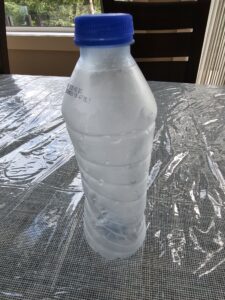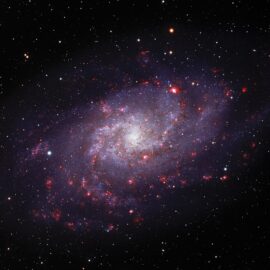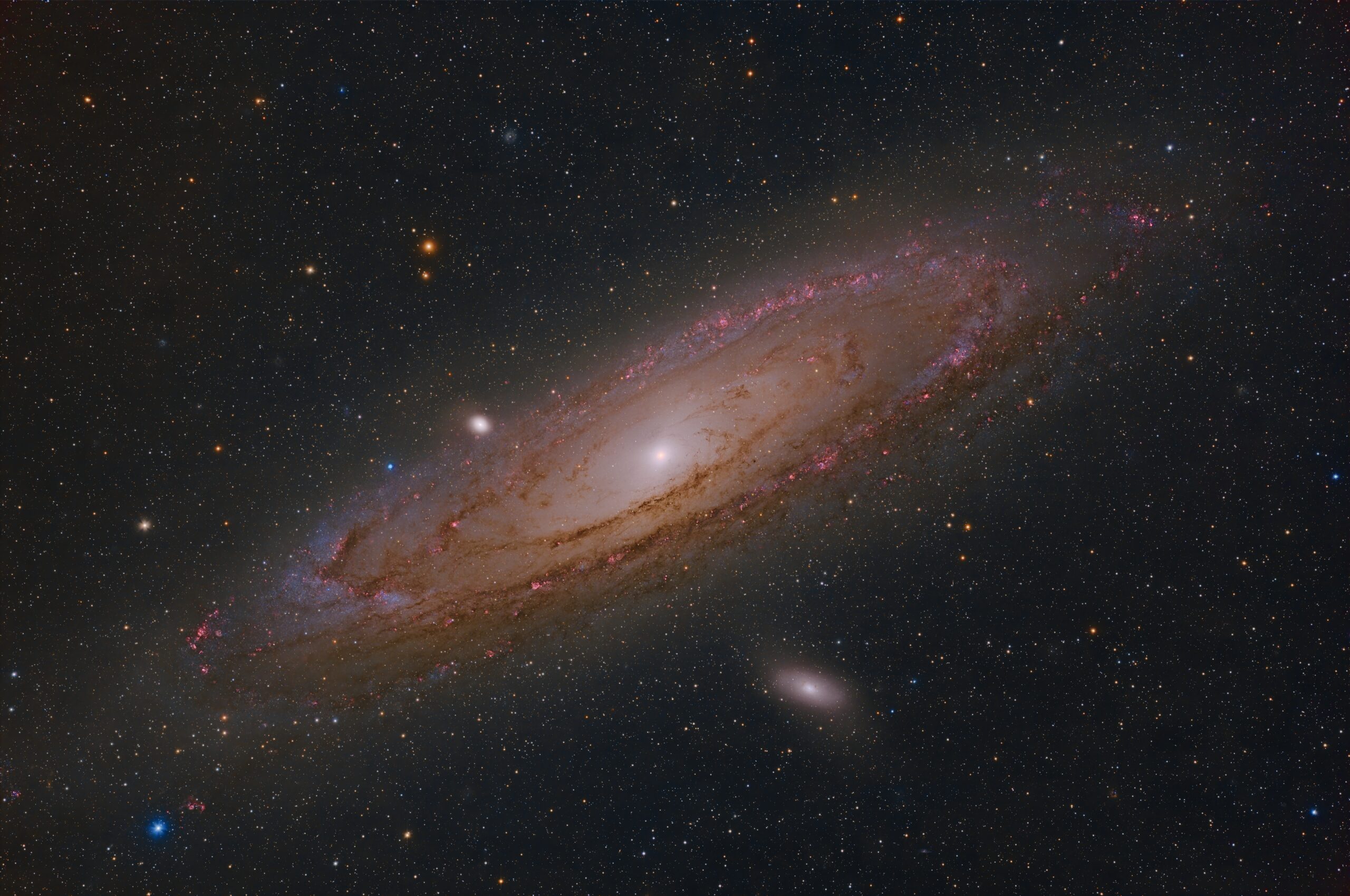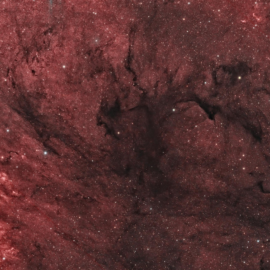
The Rotten Fish Heat Engine: LDN 1251 (Cepheus) in LRGB
Askar 151phq; AP Mach2 GTO; ASI6200MM, – Chroma LRGB
L: (85 x 150s 61 Bin 1, Gain 100), R,G,B: (43,44,38 x 180s, Bin 1, Gain 100)
Total integration time = 9.8 hrs (Aug 3,4 2024) Maple Bay, BC (RASC Zenfolio or Astrobin)
There are so many things going on in this image, and in the object itself that I admired from others’ images that I just had to image it myself. Not only is every stage of star formation (from cloud collapse to Herbig Haros) represented in this dark globule, but other features that I haven’t even begun to research or depuzzle for myself. I just want to give another shout out to SetiAstro’s “Whats in my Image” Pixinsight script and I strongly encourage you to explore your own images with it. (One of the things I want to depuzzle is how to navigate better in SIMBAD).
A couple of things come to mind – one is the two galaxies that can actually be seen through the swirling erosions and dispersion of the globular molecular cloud. If I am not mistaken, I believe we can see red Ha emissions – right through the dust and the actual (Ha adsorbant?) hydrogen of the cloud itself. The other thing I have noted, still unsure if is just my imagination, is the apparent bow front just to the left of the head of our fish and trailing to the upper and lower right in parabolic curve. Could this be radiation from the fish globule, protecting it from some relatively moving interstellar medium (ISM)? One of the reasons I did image this object was to capture a wide variety of densities that exists associated within this subject and why it appears as a “rotting” fish rather than just a fish. The wide variety of densities are evident in the light blocking capacity of the dust in the cloud – everything from “see through” – as in the galaxies to almost complete blocking of star behind the yet-to-rot fish outline. I have convinced myself, if not anyone else, that this is a consequence of cloud contraction and volatile + hydrogen/protostar condensation.
To try and convince you, I have put together an easy experiment that allows you to create a collapsing molecular cloud for yourself The apparatus consists of a bottle of drinking water where the bottle is preferably one of those flimsy one that only has strength will water in it to ensure that the pressures are not much different inside the bottle than out. Here are the instructions
- 1) Open the bottle and drink the water. (it is good to keep hydrated). Either drink the water at room temperature, or drink it cold and then allow the bottle to get to room temperature It is better if there are a few drops of water in the bottle for illustrative purposed, but it is not necessary to collapse the cloud
- 2) Put the cap on the bottle and put it in your freezer for a half to whole hour to reach heat/temperature (thermodynamic equilibrium).
- 3) Take the bottle out of the freezer and note what the bottle looks like to draw your own conclusions (before the bottle heats up).
The lower temperature of the freezer causes the molecular cloud within the bottle to collapse. It has increased in density as a response to the decrease in temperature by reducing the volume. The drop in temperature at the bottle walls, decreased the pressure within the bottle (at first at the walls) and the bottle collapsed. While the bottle is cooling, the flow of heat is from the centre of the bottle to the sides through the bottle and into the freezer. The flow of material within the bottle is also from the middle of the bottle to the colder outside but at the walls of the bottle it is stopped and is compressed. This compression of the material at the sides of the bottle is actual work done by the thermal energy as it flows out of the bottle. This is why our bottle experiment is actually a heat engine – an engine powered by heat that compresses (or collapses) our mini molecular cloud.
As this process continues, when the temperature of bottle walls first reaches the molecular cloud’s dew point temperature, which defines the amount of water than can be held by the air in the water, and water begins to condense. The water molecules release their heat of vapourization to the walls of the container and form droplets alone, or adding to existing droplets on the walls. Some water also condenses into very fine droplets within the air, creating a mist. As the temperature further decreases below the freezing point of water, these droplets become ice (releasing another batch of latent heat through the bottle into the freezer).
I contend that, just like our bottle in the freezer – the same fundamental process is going on in our molecular cloud, except the coldest part of our fish molecular cloud are in the middle of the cloud, where warming light cannot reach, and yet cooling radio/far IR can escape. The result of this cooling in LDN 1251 is the compression of the cloud making it appear darker and more opaque. The source of heat is the outside of the cloud, where all manner of radiation from UV to IR is hitting it from surrounding stars, warming to anywhere from 100s to 1000s of Kelvin. The flow of heat in LDN 1251 is from the outside of the cloud to the inner part where it is captured by the dust and radiated back out of the cloud entirely to cold, dark space (at 2.7 Kelvin). It gets cold enough in the inner part of the our fish to condense hydrogen by falling below its dew or even freezing point. Just like the bottle in the freezer, the fish molecular cloud is a heat engine – employing useful heat energy from the stars to collapse the cloud, nucleate protostars (the condensed bits) and sending the heat, spent of its useful relatively high temperature, to the cold of deep space. There is quite a bit of heat of vapourization (and isomerization) to get rid of from the middle of the cloud, but fortunately it is not being released at a single point, but rather in a distributed manner over a large number of dust grains.

After a half hour I took my bottle out of the freezer, when it should have reached thermal equilibrium within the freezer, noting that the fish molecular cloud will never reach this equilibrium condition until it stops being a heat engine too by losing its shorter wave opacity, or is self consumed making stars. Here is my “collapsed molecular cloud in a bottle”.
My bottled molecular cloud had clearly collapsed, just like the fish in our image. Frozen water (a combination of drinking water remnants + condensed water vapour) existing on the inside of the walls – like frost or dew nucleated on branches and blades of grass. It is this frozen water, that is analogous to the condensed hydrogen that existing within the coldest part of our fish nebula that will eventually become the nucleate proto stars.
The next stage of star formation in space, is get the cold, incompressible, condensed hydrogen somehow to a large mass of it and into a liquid metallic form (at high temperature and pressure) while avoiding it becoming a gas phase again and dispersing. As I will describe later, nature provides a way for this to happen without, (spoiler – a supercritical fluid).
Epilogue: Isothermal, Adiabatic Jean’s Instability Collapse.
I actually took a new bottle, drank the water and placed it very close to the surface of a planet. I used the planet to exaggerate the extremely weak gravity that would be felt by a hydrogen molecules at the edge of a molecular cloud (and covered it up to remove light as a factor and to shield myself for the impending sonic wave that was about to ensure as the cloud collapsed under its own gravity. Imagine my surprise when, nothing happened. Hmmm maybe we should give Jeans instability of (constant temperature and heat) gravitational molecular cloud collapse a second thermodynamic thought. That’s Ok, there was a lot not known about light and the UV catastrophe back when it was postulated. James Jeans had no way to get the heat out of the molecular cloud Dust, it seems, is the cosmic refrigerator.


